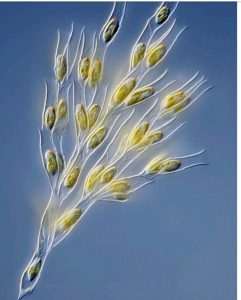Class: Chrysophyceae
- The chrysophyceae are classified within the dominion promised are mostly unicellular or colonial organisms found in fresh and saltwater throughout the planet.
Ecology:-
- Chrysophytes are predominantly found in freshwater and governments although some are marine and if you’re reported from soil or snow.
- Members of the group are widely distributed but most common in cold temperate lakes, ponds,ditches.
- Most chrysophytes are free swimming unicellular or colonial flagellates.
- Ithers are coccoid that is immobile walled unicells, amoeboid or palmelloid.
- A few species are parenchymatous.

Most chrysophytes lack cell wall but other produce species specific outer covering of scales.
Cell walls
- The cells of other species may be enclosed within an organic was like composed of cellulose and protein or chitin.
- In such spaces the lorica is typically composed of fine interwoven fibrils.
- In dinobryon this fibrils are helically arranged and secreted as the cell rotates about its longitudinal axis.
- The posterior pole of the cell is typically position and at the base of the lorica and may be attached by a fine cytoplasmic extension.
- Cells possess a single shaped nucleus that is position at the anterior end of the cell.
- The narrow end of the nucleus typically lines close to the basal bodies.

Nutrition:-
- The chrysophyceae employ a variety of means to obtain energy in which most chrysophytes are photosynthetic but It require an exogenous source of vitamin for growth.
- It is probable that all chrysophytes are facultatively osmotrophic that is, they are capable of directly absorbing small inorganic or organic molecules from the surrounding medium.
- Several species particularly those with leucoplast are obligate heterotrophs that are consume small organic particle.
Reproduction:-
- A sexual reproduction in amoeboid and flagellate species occurs by longitudinal division of the cell fragmentation is common among colonial palmelloid and parenchymatous species.
- Some taxa, such as the parenchymatous genera phaeodermatium and Hydrurus or members of the palmelloid family Chrysophyceae reproduce by means of flagellated swarmers.
- Under certain environmental condition Silicified resting cysts are produced by many species.
- Depending on the species cytoplasm located outside the cyst wall may or may not be absorbed through the porous which at maturity is occluded by a pactic plug.
- Sexual reproduction is known only in a handful of species. in those cases absorbed vegetative cells behave as gametes and fuse epically.
- The resulting Quadri flagellate cell will insist forming sexually derived by nuclear hypnozgotes.
- It is presumed that karyogamy and meiosis occurs within the system but this process have yet to be studied.
Importance:-
- It is considered as helpful to humans. Normally we use them in in toothpaste, scouring products and filters.
- As autotrophs they provide a substantial amount of oxygen to the environment.
- Also they store their food as oil they can be used for biofuel.
- These are specially used in biobutanol production because of their small size.
References